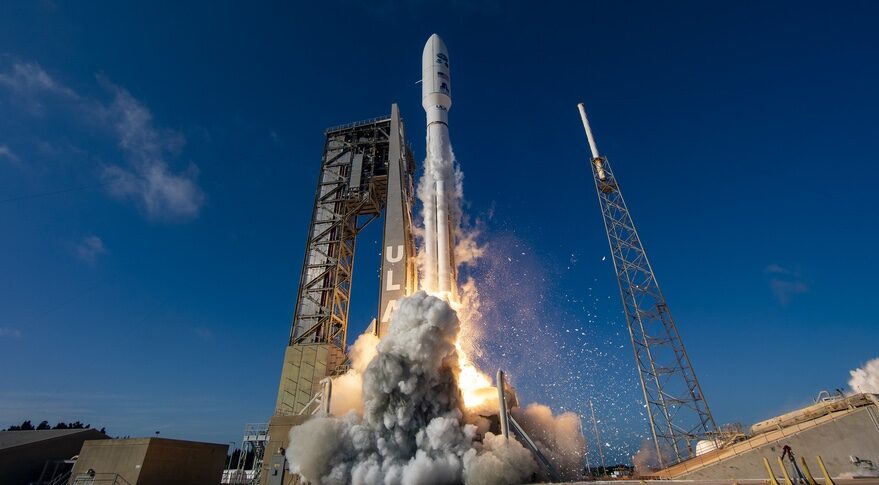WASHINGTON — An Atlas 5 successfully launched the latest in a series of geostationary weather satellites March 1, exactly four years after the launch of the satellite it is replacing.
A United Launch Alliance Atlas 5 lifted off from Space Launch Complex 41 at Cape Canaveral Space Force Station on schedule at 4:38 p.m. Eastern. The Centaur upper stage deployed its payload, the Geostationary Operational Environmental Satellite (GOES) T, more than three and a half hours later into a geostationary transfer orbit.
The Centaur performed three burns to place the spacecraft in a transfer orbit with a higher perigee, in this case nearly 8,900 kilometers, than a typical geostationary transfer orbit. That is intended to shorten the time and reduce the propellant needed to reach geostationary orbit.
“We do that final third burn to just get them right where they want to be,” Scott Messer, program manager for NASA launch services at ULA, said at a Feb. 26 briefing.
The spacecraft, which the National Oceanic and Atmospheric Administration will rename GOES-18, will initially be checked out at 89.5 degrees west in GEO. The spacecraft will then drift to 136.8 degrees west, the GOES-West slot, by August for final testing. It will take over as the operational GOES-West satellite in early January of 2023, said Candace Carlisle, flight project manager for the GOES-R series of satellites at NASA’s Goddard Space Flight Center, during a Feb. 25 briefing.
GOES-18 will take over for GOES-17, which launched as GOES-S on an Atlas 5 exactly four years ago. A problem with the performance of its main weather instrument, the Advanced Baseline Imager (ABI), led NOAA to replace it with GOES-18. Once GOES-18 takes over as GOES-West, GOES-17 will move into on-orbit storage at 105 degrees west, ready to take over for either the GOES-16 satellite in the GOES-East slot or GOES-18 encounters problems.
GOES-T is the third of four satellites in the GOES-R series of geostationary weather satellites built by Lockheed Martin. The fourth, GOES-U, is scheduled to launch in 2024 on a SpaceX Falcon Heavy. The satellites carry a suite of instruments like ABI that have improved both terrestrial weather forecasting and space weather monitoring.
“GOES-T will help improve NOAA’s numerical weather prediction models used by National Weather Service forecasters,” said Jim Yoe, chief administrator of the Joint Center for Satellite Data Assimilation, at the Feb. 25 briefing. The GOES-West satellite is particularly important, he noted, because most weather systems travel from west to east.
“Besides our work on spacecraft development and launch, NASA-supported science teams are looking forward to analyzing the precious data that GOES-T will provide,” Thomas Zurbuchen, NASA associate administrator for science, said in a statement after the launch. “These observations are a key part of our research towards improving understanding and models of climate, weather and space weather — models that, in turn, support NOAA’s crucial work as they lead the weather and space weather forecasts for the nation.”
The launch was the first of the year managed by NASA’s Launch Services Program, which handles launches of NASA science and related missions. At a Feb. 26 briefing, launch director Tim Dunn said the program had three other major missions to launch this year. A Falcon Heavy will launch the Psyche asteroid mission in August from the Kennedy Space Center, followed by the September launch of the Joint Polar Satellite System 2 spacecraft with NOAA from Vandenberg Space Force Base and then the Surface Water and Ocean Topography mission on a Falcon 9 from Vandenberg in November.
In addition, he said the program is overseeing the launch of the CAPSTONE cubesat mission to the lunar near-rectilinear halo orbit, scheduled for late spring on a Rocket Lab Electron rocket. It is also responsible for the launches of six Time-Resolved Observations of Precipitation Structure and Storm Intensity with a Constellation of SmallSats (TROPICS) cubesats on three Rocket 3.3 vehicles from Astra Space. Those launches, from Cape Canaveral, are currently scheduled for late spring through early summer, pending the outcome of the investigation into Astra’s Feb. 10 launch failure.

